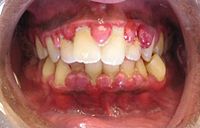
Photo from wikipedia
Histoplasmosis, caused by the dimorphic environmental fungus Histoplasma capsulatum, is a major mycosis on the global stage. Acquisition of the fungus by mammalian hosts can be clinically silent or it… Click to show full abstract
Histoplasmosis, caused by the dimorphic environmental fungus Histoplasma capsulatum, is a major mycosis on the global stage. Acquisition of the fungus by mammalian hosts can be clinically silent or it can lead to life-threatening systemic disease, which can occur in immunologically intact or deficient hosts, albeit severe disease is more likely in the setting of compromised cellular immunity. H. capsulatum yeast cells are highly adapted to the mammalian host as they can effectively survive within intracellular niches in select phagocytic cells. Understanding the biological response by both the host and H. capsulatum will facilitate improved approaches to prevent and/or modify disease. This review presents our current understanding of the major pathogenic mechanisms involved in histoplasmosis.
Journal Title: Current topics in microbiology and immunology
Year Published: 2018
Link to full text (if available)
Share on Social Media: Sign Up to like & get
recommendations!